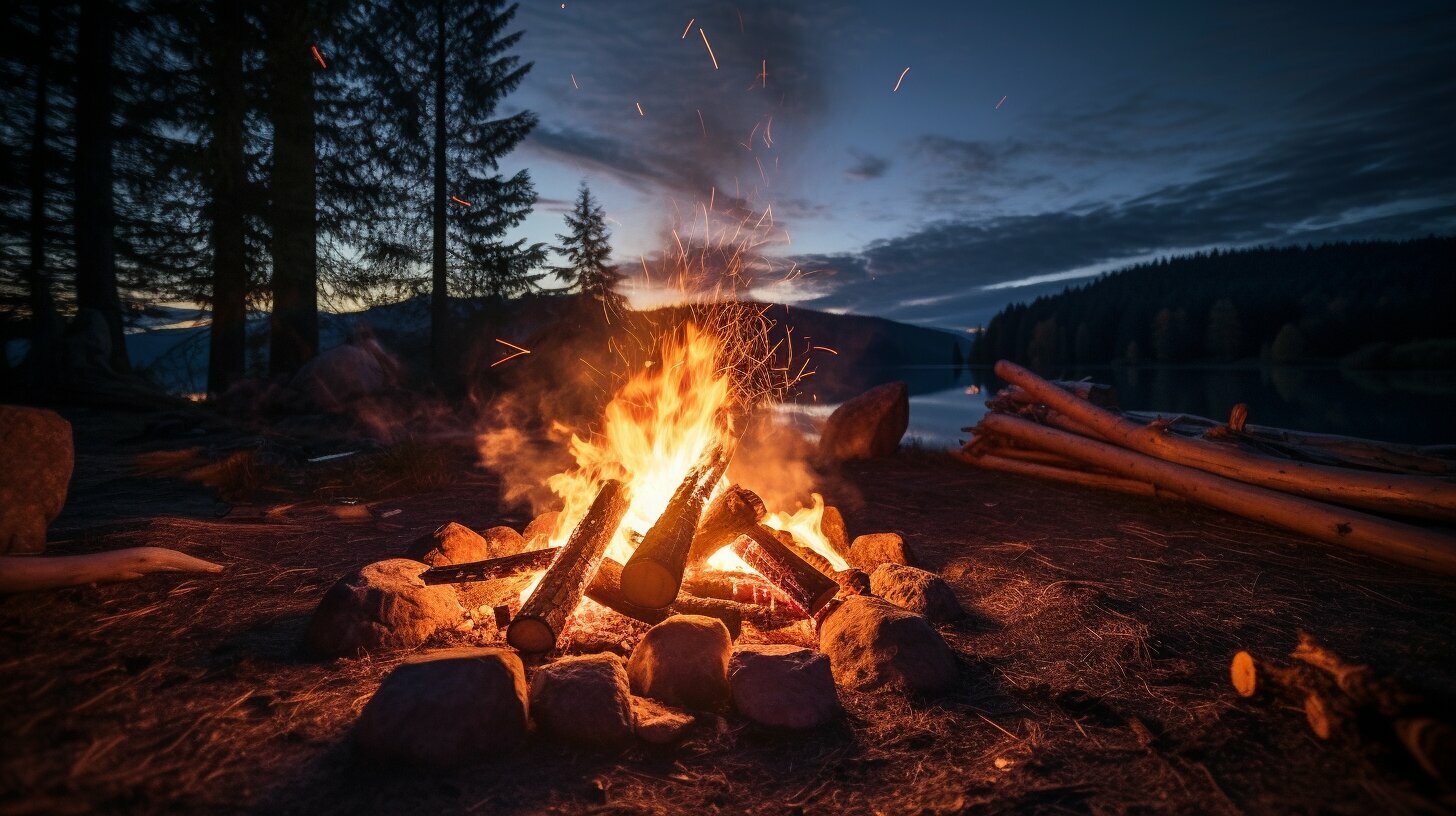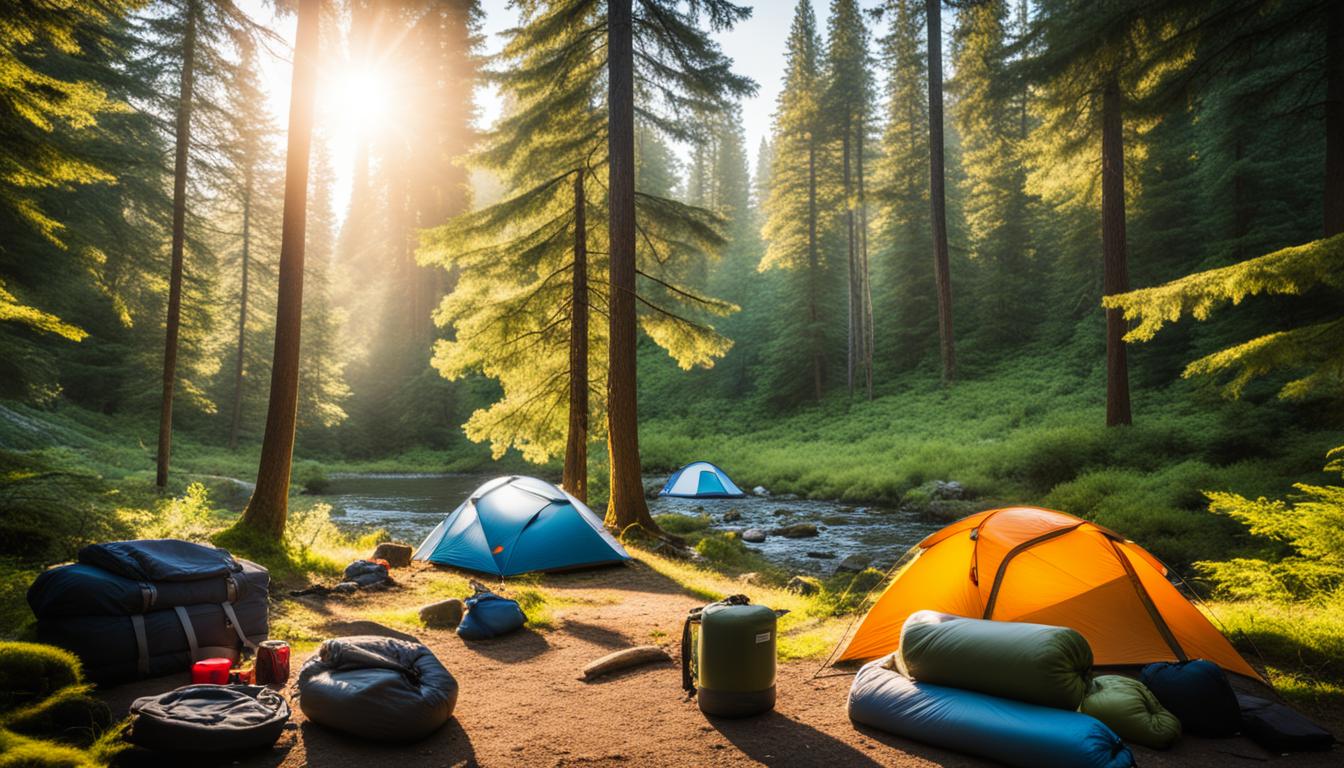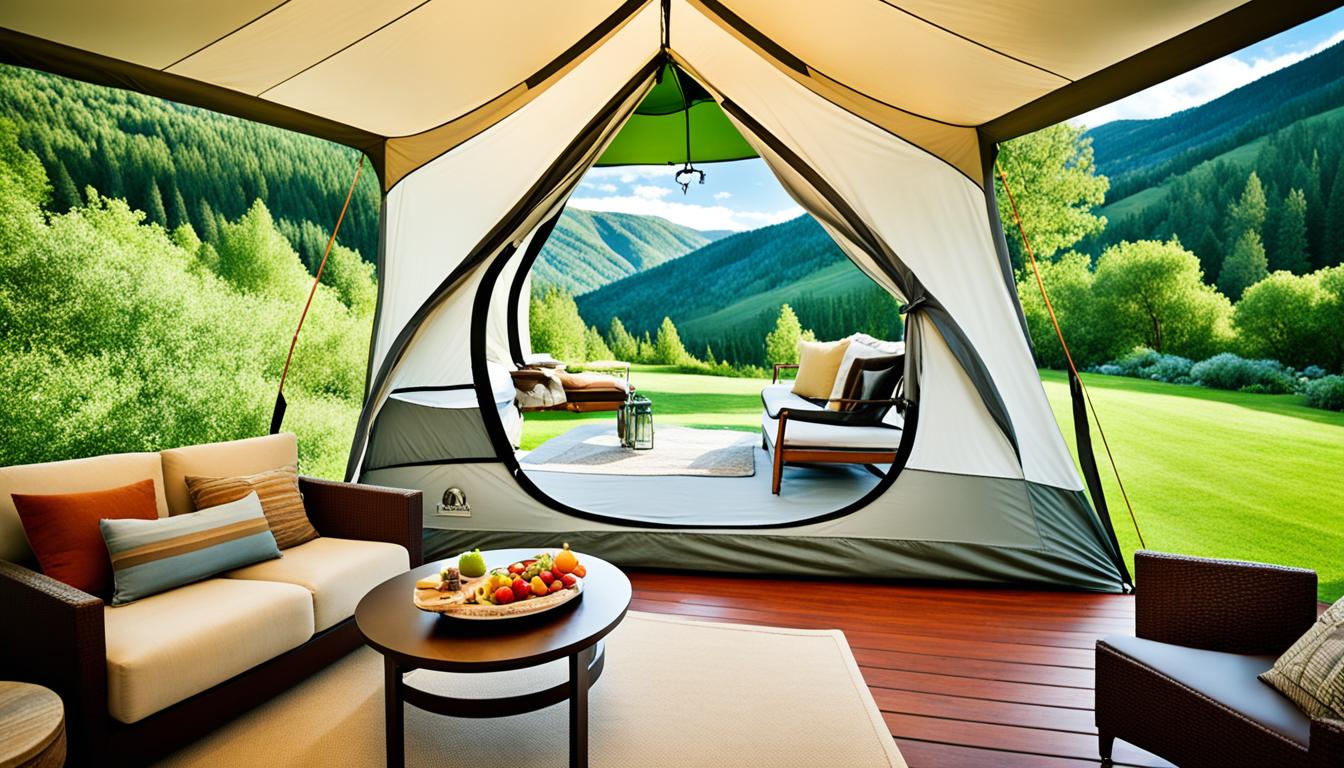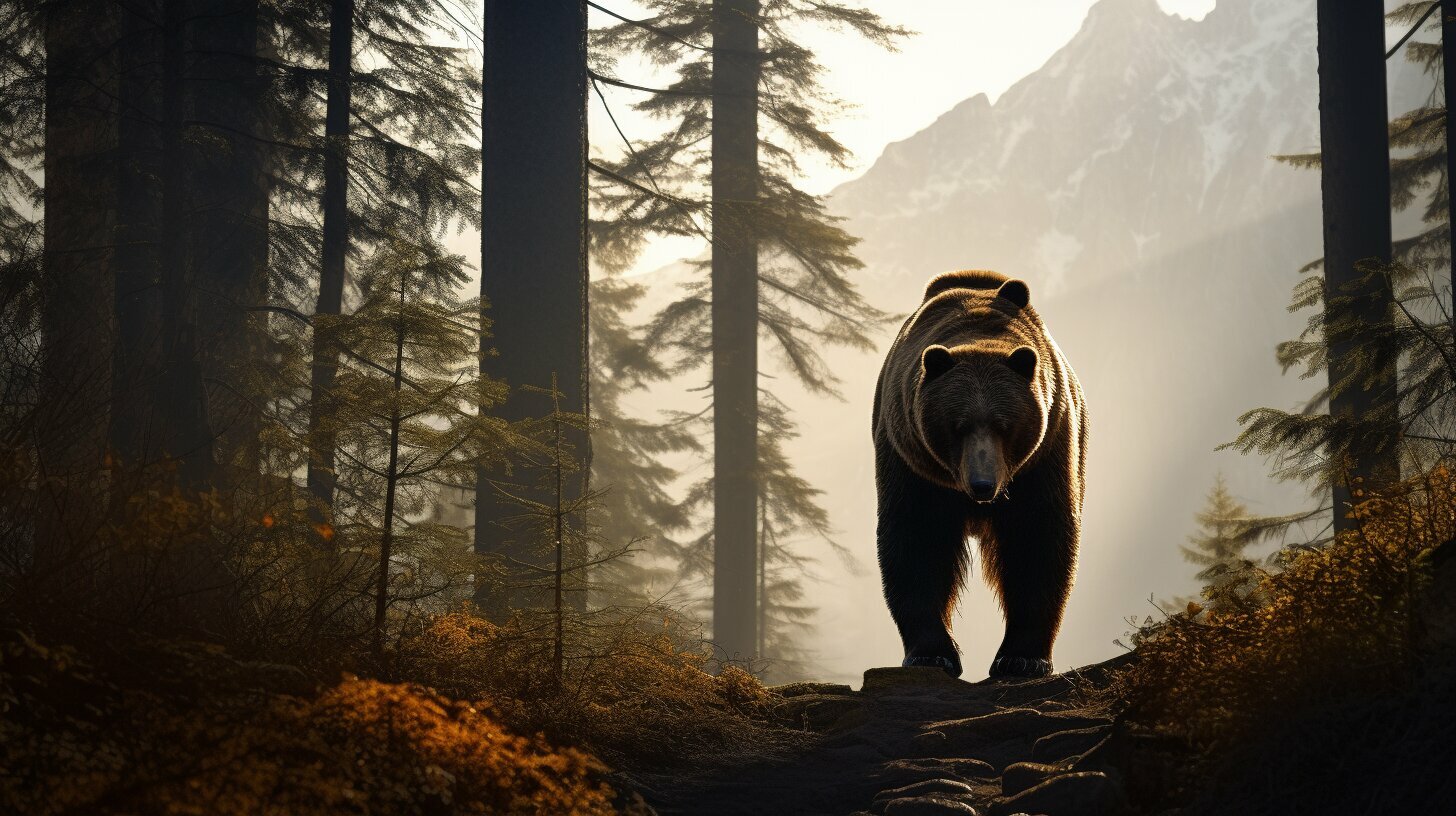Building a campfire is an essential skill for anyone who loves spending time in the great outdoors. But if you’ve never built a campfire before, or you’re looking to improve your skills, it can be intimidating. That’s why we’ve created this comprehensive guide to help you master the art of campfire building.
From choosing the right materials to ensuring safety and efficiency, we’ll cover everything you need to know to create the perfect campfire for your next outdoor adventure. Whether you’re planning a camping trip with friends or a quiet night under the stars, building a campfire is a must-do activity. So, let’s get started!
Key Takeaways
- Building a campfire is an essential skill for anyone who loves spending time in the great outdoors.
- This comprehensive guide will help you master the art of campfire building.
- Follow our tips and techniques to ensure a safe and enjoyable campfire experience.
- From choosing the right materials to ensuring safety and efficiency, we cover everything you need to know.
- Building a campfire is a must-do activity for any camping trip or outdoor adventure.
Understanding the Basics of Campfire Building
Before you start building your campfire, it’s essential to understand the basics of campfire building tips and the materials needed. Knowing these tips and materials will make the difference between a successful and enjoyable campfire and a frustrating experience.
One of the most important campfire building tips is to choose the right materials. You’ll need dry, seasoned wood that’s easy to ignite and will burn well. This might include small sticks, twigs, and larger logs.
Disclosure: When you buy through links on our site, we may earn an affiliate commission.
Another essential tip is to create a suitable location for your campfire. Ideally, you should build your campfire in a designated fire pit or ring, or at least an area that is clear of any flammable materials.
Once you have your materials and location, it’s time to start building your campfire. There are several different types of campfires you can build, including the teepee, log cabin, and pyramid fire lays. Each requires different arrangements of the kindling and firewood, so be sure to research which technique is best for you.
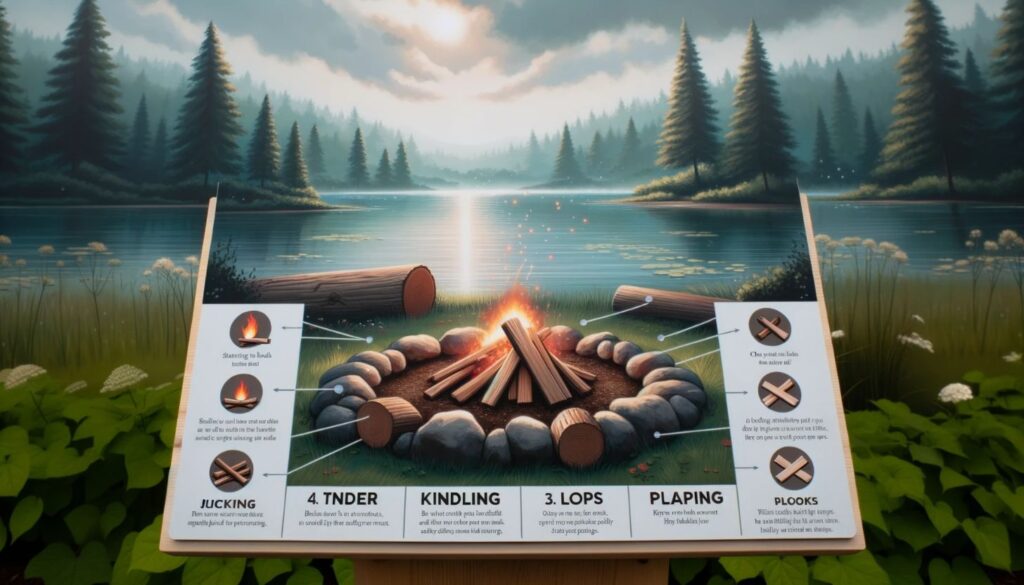
By understanding the basics of campfire building tips and materials, you’ll have a solid foundation for building the perfect campfire.
Selecting the Perfect Location for Your Campfire
To ensure the safety of you and your fellow campers, it’s essential to choose a suitable location for your campfire. Consider the following campfire safety precautions:
- Keep your campfire at least 10 feet away from any flammable objects. This includes trees, bushes, tents, and other campers’ belongings. Sparks can fly and ignite nearby objects, so it’s important to clear the area around your campfire.
- Choose a spot that is sheltered from wind. Wind can cause your fire to spread quickly and unpredictably, so it’s best to choose a spot that is protected from strong gusts.
- Use an established fire pit or ring, if available. Many campgrounds and parks have designated fire pits or rings that are specifically designed for campfires. These areas are often lined with rocks or metal and are located away from flammable objects.
- Make sure the ground is clear of any flammable objects. If you are unable to use an established fire pit or ring, it’s important to clear the area of any debris or flammable objects. Use a shovel or rake to create a small, flat area for your fire.
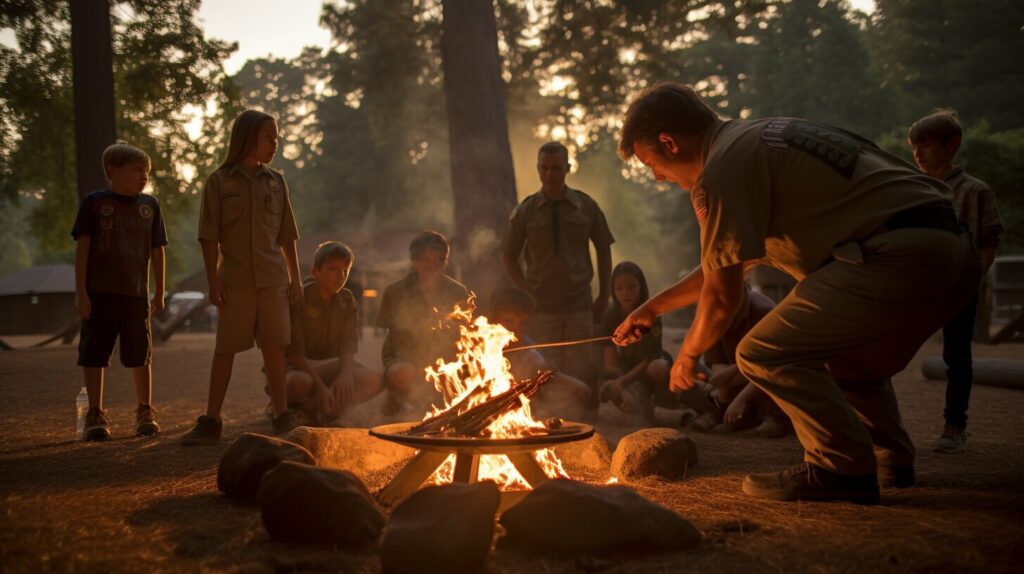
Remember, always follow campfire safety precautions to protect yourself and others while enjoying the outdoors.
Gathering and Preparing Campfire Materials
Now that you understand the basics of campfire building, it’s time to gather the right materials. The best way to build a campfire is to start with the proper materials.
The three essential components of a campfire are fuel, kindling, and tinder. Fuel consists of larger logs that will sustain your fire, kindling is smaller sticks and twigs that will help ignite the fire, and tinder is smaller pieces of material that will easily catch fire and ignite the kindling.
When gathering materials, choose dry wood that snaps easily and produces a clean break. Wet wood can be difficult to ignite and will produce more smoke.
It’s important to gather all your materials before you begin building your campfire. This will make the process smoother and more efficient.
Campfire materials checklist:
- Dry, seasoned firewood
- Kindling sticks and twigs
- Tinder materials such as dry leaves, grass, or newspaper
Preparing your materials is crucial for a successful fire. You can split your larger logs into smaller pieces using an ax or hatchet. This will provide a surface area for oxygen to reach the wood and improve combustion. Remove any bark from the wood, as this can harbor moisture and deter combustion.
Break your kindling into small, finger-sized pieces. This will make them easier to ignite and help them catch fire quickly.
When preparing your tinder, make sure it’s dry and flammable. You can crumple up small pieces of newspaper, or use dry grass or leaves.
Once you’ve gathered and prepared your materials, you’re ready to move on to the next step: building your campfire.
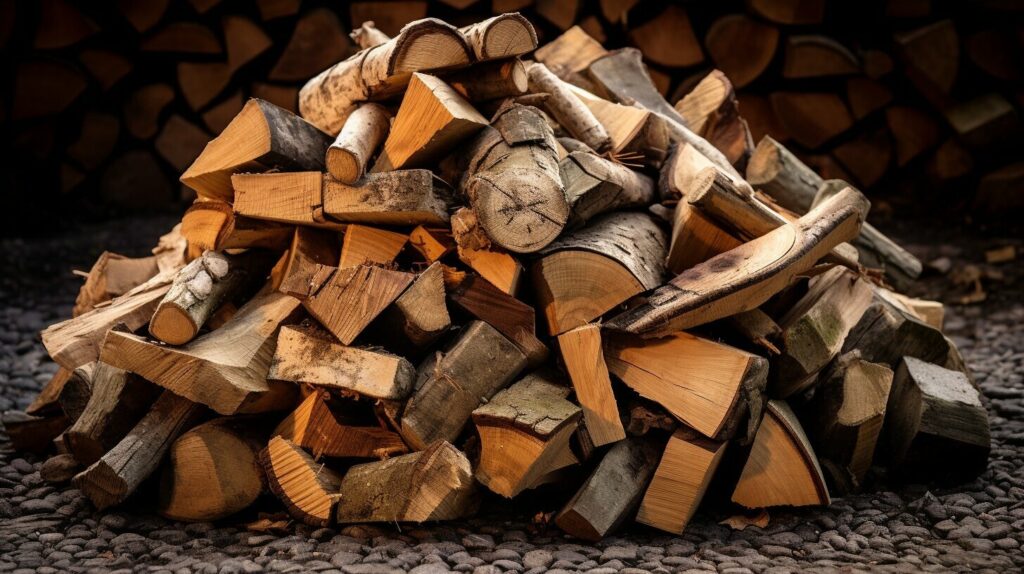
How to Build the Perfect Campfire
Building a campfire is an essential part of any camping or outdoor experience. Follow these step-by-step instructions to ensure that your campfire is efficiently built and safely managed.
Gather Your Materials
Start by gathering the materials you will need for your campfire. You will need three types of materials: tinder, kindling, and fuel wood.
Tinders are small, dry, and easily flammable materials, such as dry leaves or paper. Kindling is slightly larger and thicker than tinder and includes twigs or small branches. Fuel wood is the largest material and logs that will keep the fire burning for a long time.
Choose Your Fire Lay Technique
There are three main fire lay techniques you can use when building your campfire: teepee, log cabin, and pyramid.
The teepee lay is when you lean the kindling inwards towards the center, creating a tepee shape. The log cabin lay is when you criss-cross two sets of kindling perpendicularly, alternating directions to create a square shape. The pyramid lay is when you create a pyramid shape with the kindling, with a small amount of tinder at the center.
Build Your Campfire
Start by placing your tinder in the center of your fire pit, then add the kindling, making sure to leave enough space for the tinder to breathe.
Light the tinder and wait for it to catch before gradually adding more kindling. As the fire grows, you can add larger fuel wood pieces.
Manage and Control Your Campfire
As your campfire grows, be sure to manage and control it to ensure safety. Never leave your campfire unattended and never add too much fuel at once.
If you need to adjust the heat level, simply add or remove fuel wood. To extinguish the fire, spread out the embers and pour water over them until there is no smoke or hissing sound.
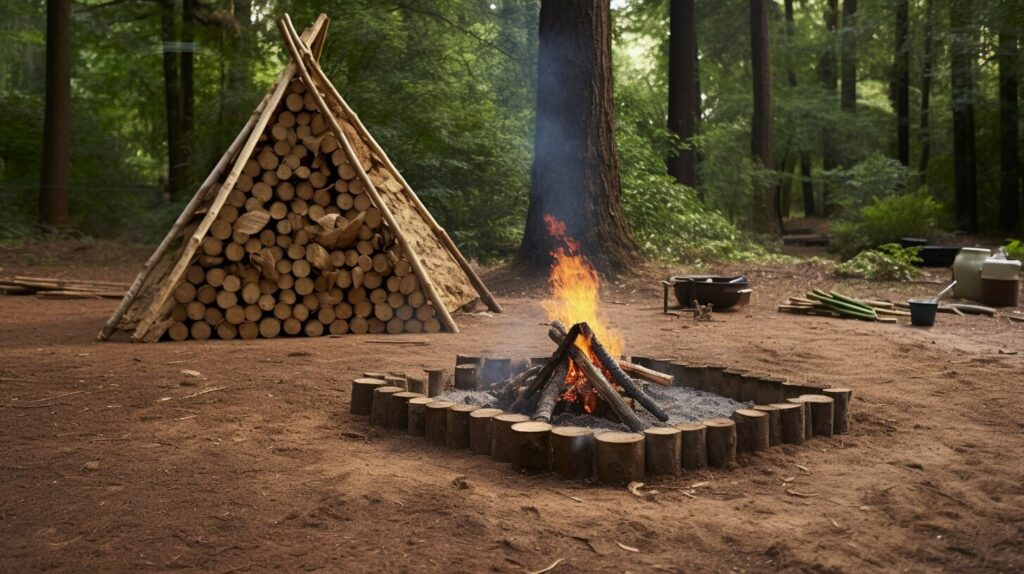
Campfire building techniques can vary, but by following these step-by-step instructions, you can ensure a safe and enjoyable campfire experience.
Igniting Your Campfire Safely
As you prepare to light your campfire, it’s essential to keep safety in mind. Follow these campfire safety precautions:
- Ensure there are no overhanging branches or other flammable materials around the fire pit.
- Choose an area that is sheltered from wind gusts. Wind can blow embers and sparks onto nearby vegetation, which can start a wildfire.
- Only use matches, lighters, or fire starters to ignite your campfire. Never use gasoline or other flammable liquids.
- Keep a bucket of water, sand, or a shovel nearby in case the fire needs to be extinguished quickly.
- Never leave a campfire unattended. Always make sure someone is actively watching the fire.
Once you’ve got your fire started, be sure to keep it under control:
- Add additional wood slowly and gradually to maintain a steady fire.
- Avoid creating a fire that is larger than necessary.
- If the fire begins to grow out of control, use the water, sand, or shovel to quickly extinguish it.
- When you’re ready to leave your campsite, be sure to properly extinguish the fire by pouring water or sand over the ashes. Stir the ashes and repeat the process until the fire is completely out.
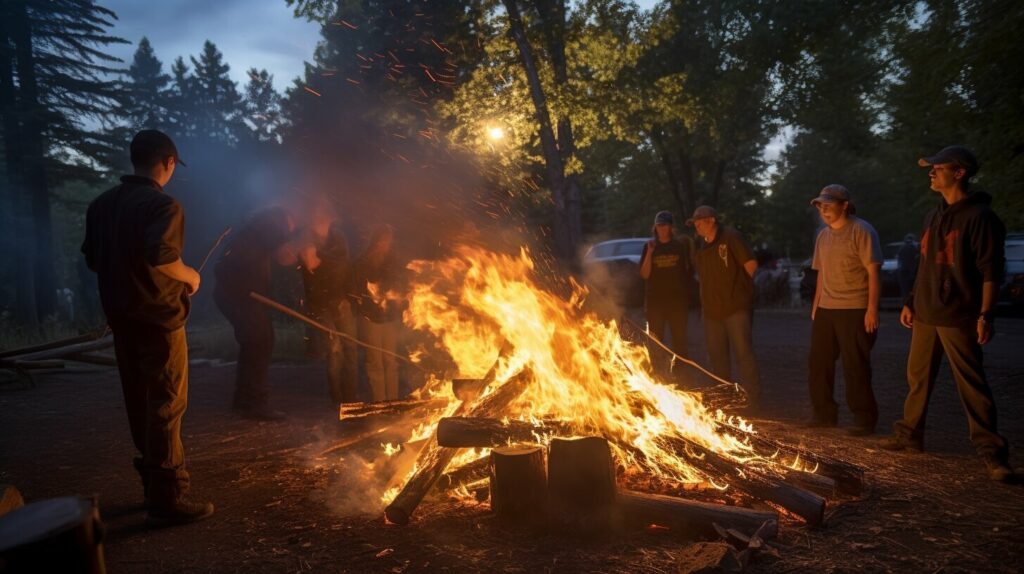
Following these campfire safety precautions is essential for a successful and enjoyable camping experience.
Maintaining and Controlling Your Campfire
Once your campfire is burning, it’s important to maintain and control it properly to ensure safety. The following tips will help you enjoy your campfire responsibly:
- Keep a bucket of water or a shovel nearby in case of emergencies.
- Do not leave your campfire unattended, even for a short time.
- Only add small pieces of wood to the fire to control the heat.
- Do not poke or stir the fire unnecessarily, as it can cause embers to fly out.
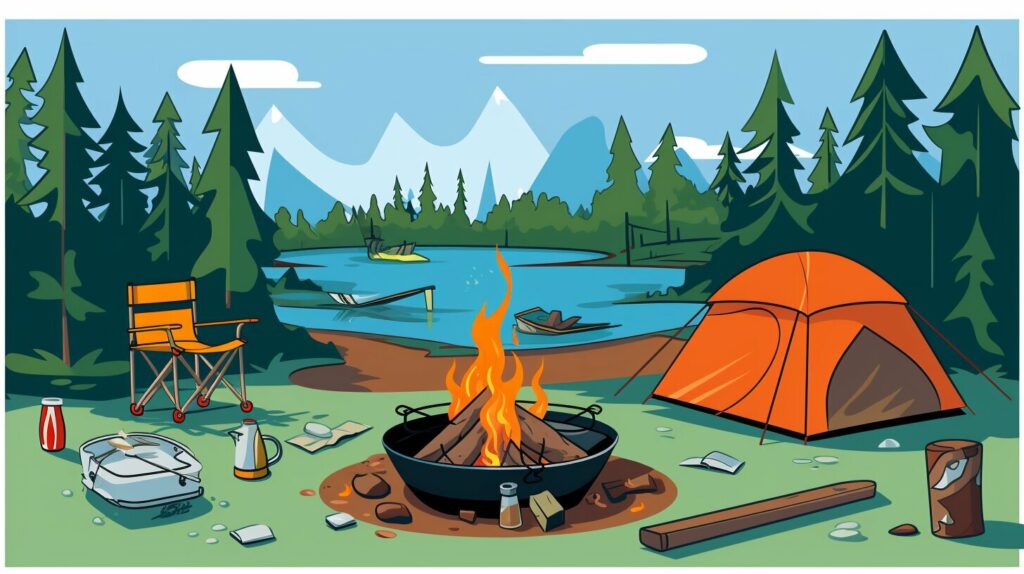
If you need to extinguish your campfire, the best way is to let it burn down to ash and then pour water over it until the hissing sound stops. Use a shovel to stir and spread the ashes to ensure all the embers are extinguished.
By following these safety precautions, you can enjoy your campfire while minimizing the risk of accidents or wildfires.
Campfire Etiquette and Leave No Trace Principles
Building a campfire is a great way to enjoy the great outdoors, but it’s important to do so responsibly. By following proper campfire etiquette and Leave No Trace principles, you can minimize your impact on the environment and preserve natural habitats for future generations.
Campfire Etiquette
When building a campfire, there are a few key things to keep in mind:
- Always use an existing fire ring or build a new one in a safe location.
- Never leave your campfire unattended, and always fully extinguish it before leaving.
- Be mindful of your neighbors and keep your campfire smoke from drifting into their campsites.
- Avoid burning trash or leaving any litter in the fire pit.
By following these guidelines, you can minimize your impact on the environment and ensure a safe and enjoyable camping experience for all.
Leave No Trace Principles
Leave No Trace is a set of principles designed to help outdoor enthusiasts minimize their impact on the environment. When building a campfire, there are a few key Leave No Trace principles to keep in mind:
- Choose a campfire location that is at least 200 feet from lakes and streams to prevent water contamination.
- Use only sticks and twigs that are already on the ground for kindling and fuel.
- Avoid building a large fire that will create unnecessary damage to the surrounding area.
- Leave the campsite cleaner than you found it by properly disposing of all trash and litter.
By following these principles, you can enjoy the beauty of nature while minimizing your impact on the environment.
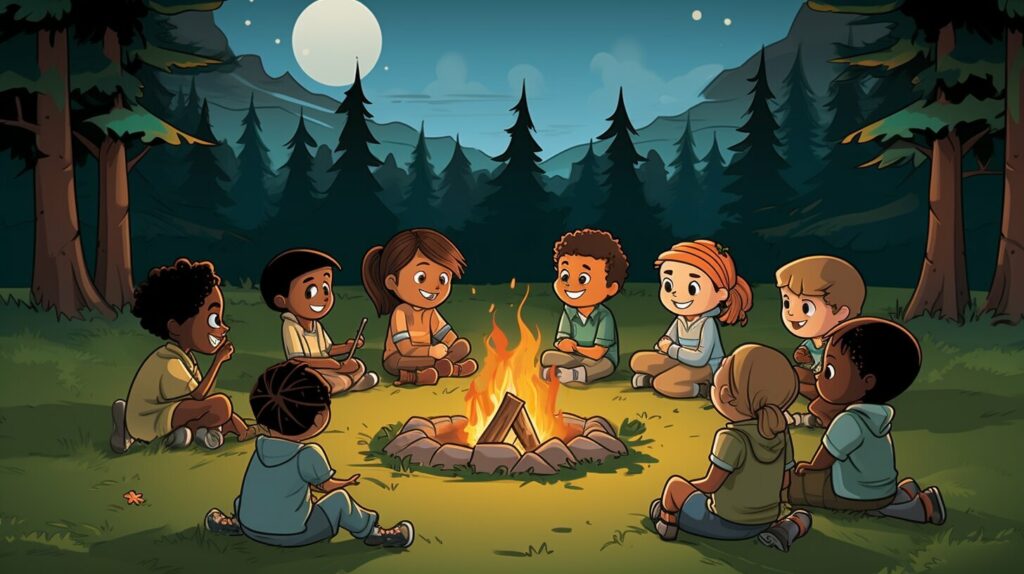
Elevate Your Camping Meals with Campfire Cooking
Take your camping experience to the next level by cooking over your campfire. There’s something magical about preparing food outdoors, and the added smoky flavor makes it even more delicious. Here are some tips to get you started:
- Bring a cast-iron skillet or Dutch oven. These are great for cooking over an open flame and can be used for a variety of dishes.
- Choose easy recipes that don’t require too many ingredients or prep time. One-pot meals like chili, stews, and soups are perfect for campfire cooking.
- Before adding food to the skillet or pot, make sure the fire has died down and you have a bed of hot coals to cook on.
- Use long-handled utensils to avoid burning yourself.
- Don’t forget to pack some aluminum foil. It’s great for wrapping up food and cooking it over the flames.
Here are a few recipes to try on your next camping trip:
| Recipe | Description |
|---|---|
| Campfire Nachos | A fun and easy meal that everyone will love. Layer tortilla chips, cheese, beans, and any other toppings you like in a cast-iron skillet or Dutch oven. Cook over hot coals until the cheese is melted and bubbly. |
| Hobo Packets | A classic campfire meal that’s easy to customize. Simply place your choice of protein (chicken, beef, or shrimp), vegetables, and seasonings onto a sheet of aluminum foil. Fold the foil to create a packet, then cook over hot coals until everything is tender and cooked through. |
| Grilled Corn on the Cob | One of the easiest and tastiest ways to cook corn. Simply shuck the corn, brush with butter and seasonings, then grill over hot coals until charred and tender. |
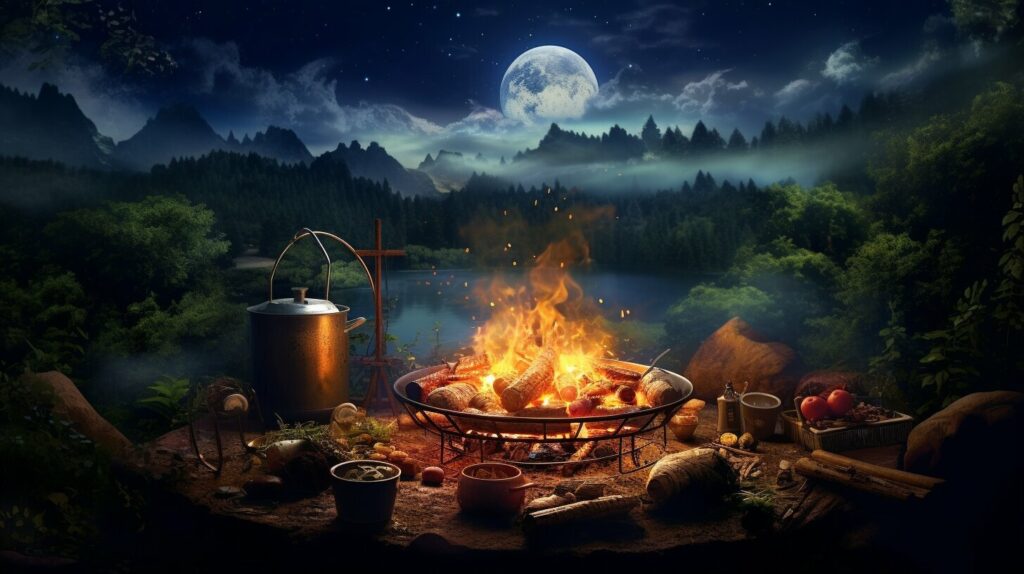
With these tips and recipes, you’ll be able to create delicious meals over your campfire and make lasting memories with your loved ones.
Conclusion
Building a campfire is an essential skill for anyone who loves the outdoors. By following the tips and techniques outlined in this campfire building guide, you can safely and efficiently build the perfect fire for your outdoor adventures.
Remember to always prioritize safety when building a campfire. Choose a suitable location, gather the right materials, and follow proper safety precautions when igniting and maintaining your fire.
Additionally, practicing responsible campfire etiquette and Leave No Trace principles is vital for preserving our natural environments. By leaving the wilderness as we found it, we can ensure that future generations can enjoy the beauty of these natural spaces.
Finally, take your campfire experience to the next level by cooking over the fire! With the right materials and techniques, you can create delicious meals that are perfect for outdoor cooking. So, grab your gear and get ready to master the art of building a campfire!
FAQ
How do I choose the right location for my campfire?
When selecting a location for your campfire, make sure to choose a spot that is at least 15 feet away from flammable objects such as tents, trees, or shrubs. Also, consider the wind direction to prevent the fire from spreading uncontrollably. Finally, use a fire pit or ring to contain the fire and protect the surrounding area.
What materials do I need to gather for building a campfire?
To build a campfire, you’ll need three main materials: firewood, kindling, and tinder. Firewood should be dry and seasoned, preferably hardwood, and should be broken into manageable sizes. Kindling consists of small twigs and sticks, while tinder is highly flammable material such as dry leaves or small shavings. Gathering these materials before starting your fire is essential.
How do I safely light my campfire?
To safely ignite your campfire, start by creating a small pile of tinder in the center of your fire pit. Use matches, a lighter, or a fire starter to light the tinder. Once the tinder is burning, gradually add kindling and firewood to build the fire. Remember to never leave a fire unattended and always keep a bucket of water or a fire extinguisher nearby for emergencies.
How can I control and maintain my campfire?
To control and maintain your campfire, you can add more firewood as needed to keep the fire going. Adjust the heat level by arranging the logs closer together or spreading them apart. Always monitor the fire and ensure it stays within the bounds of your fire pit or ring. When you’re ready to leave, use water or sand to fully extinguish the fire, making sure it is completely out.
What is campfire etiquette and why is it important?
Campfire etiquette refers to the responsible practices and behavior associated with having a campfire. It includes leaving no trace by properly extinguishing the fire, not burning anything that could be harmful to the environment, and being mindful of noise and smoke. Following campfire etiquette helps preserve the natural environment for future visitors and ensures a positive camping experience for everyone.

